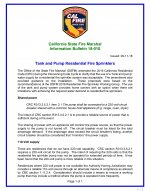Failed an inspection for a detached garage / office. Nothing crazy, 60a subfeed, handful of circuts for lighting and receptacles, 20a mini-split A/C and a "fire pump". I've done a bunch of these before. It's a 200-600 gal tank with a 240v 1-2hp booster pump that sits in the garage or outside the house when there is not adequate water flow available from the city supply or well.
Provided it a dedicated 20a 240v circuit and pull out disconnect next to the pump as usual. Fire Marshall came and said it needed to be on a 240v appliance circuit. Couldn't believe this was in the building code, but sure enough it was.
Don't really see how this can be met legally in most instances. This AC had a maximum 20a OCPD, I guess I'd have to run a 40a circuit to a junction box, then split off to fused disconnects, one for the A/C and one for the pump. Which entirely defeats the purpose of the "logic" behind this. Nothing is preventing the local disconnect from being shut off.
Fire Marshal settled on installing a 240v indicator in the building labeled "Danger, fire pump offline when not lit". Said that nobody has done it before, they just tie it to a dryer or ac breaker. Not upsizing the breaker or anything. Just run the same size wire.
Why a breaker lock isn't an acceptable solution is beyond me.

Provided it a dedicated 20a 240v circuit and pull out disconnect next to the pump as usual. Fire Marshall came and said it needed to be on a 240v appliance circuit. Couldn't believe this was in the building code, but sure enough it was.
Don't really see how this can be met legally in most instances. This AC had a maximum 20a OCPD, I guess I'd have to run a 40a circuit to a junction box, then split off to fused disconnects, one for the A/C and one for the pump. Which entirely defeats the purpose of the "logic" behind this. Nothing is preventing the local disconnect from being shut off.
Fire Marshal settled on installing a 240v indicator in the building labeled "Danger, fire pump offline when not lit". Said that nobody has done it before, they just tie it to a dryer or ac breaker. Not upsizing the breaker or anything. Just run the same size wire.
Why a breaker lock isn't an acceptable solution is beyond me.

